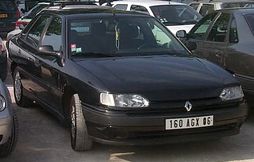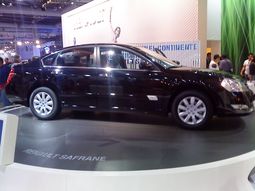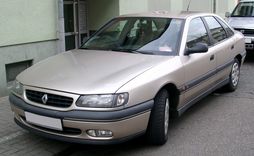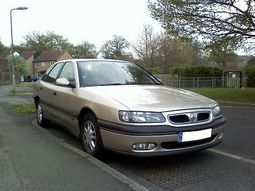The History Of Renault Safrane

The Renault Safrane was an executive car designed and built by the French manufacturer Renault from 1992 to 2000. Throughout its lifespan it remained the most expensive and most luxurious Renault available. It was replaced by the Vel Satis, and to some extent by the short-lived two-door Avantime.
The Safrane was launched in late 1992 to replace the ageing Renault 25 in the full-size market segment. Its clean, aerodynamic styling was quite conservative and very typical of early 1990s car design, also quite reminiscent of the 25's.
All Safranes were five-door liftbacks with transversely mounted engines. Front-wheel drive and four-wheel drive versions were available, with a range of petrol or diesel engines and manual or automatic transmissions. All petrol engines were fuel-injected and were fitted with three-way catalytic converters, as required in Europe after 1993 for engines of all sizes. The Safrane was also the first Renault to be equipped with air bags.
The Safrane carried over the Renault 25's five-door hatchback design that had gained wide customer acceptance in France. Despite the traditional preference for sedan bodies in the executive car segment, Renault decided to compete on the base of added practicality of the rear tailgate and split-folding rear seat (not available from most sedan-bodied competitors), as well as originality. Given the preference for German sedans from Audi, BMW and Mercedes-Benz of many executive car buyers, this can be viewed as good marketing tactics, allowing Renault to draw the buyers looking for alternatives, rather than compete head-on. The Safrane featured slightly (but visibly) different front ends in different versions, in an attempt to emphasize the unique status of more upmarket models.
The Safrane's design was a deliberate effort to overcome the R25's main weaknesses - insufficient chassis stiffness and poor build quality. Renault was also keen to take noise reduction to best-in-class levels. These constraints resulted in a much heavier car than its predecessor (+200-300 kg / 440-660 lb.) due to a heavily reinforced chassis and the liberal use of sound-proofing materials.
At launch in 1992, the Safrane offered six engines including one diesel:
- 2.0L (1995cc), 8v I4, 107PS (79kW; 106hp) (in markets where engine size was a factor in yearly registration costs)
- 2.2L (2165cc), 8v Douvrin I4, 110PS (81kW; 108hp) (in other markets)
- 2.0L (1995cc), 12v I4, 140PS (103kW; 138hp) (in markets where engines above 2.0L are heavily taxed)
- 2.2L (2165cc), 12v Douvrin I4, 140PS (103kW; 138hp) (in other markets)
- 3.0L (2963cc), 12v PRV V6, 167PS (123kW; 165hp)
- 2.1L (2068cc), 8v I4 turbodiesel, 90PS (66kW; 89hp)
- 2.5L (2499cc), 8v I4 VM turbodiesel, 115PS (85kW; 113hp)
The Safrane's launch was free of the build quality problems that ruined the Renault 25's reputation. Critics praised the car's comfortable and spacious interior, excellent noise insulation, and incisive handling. However, the manual transmission's cable-actuated shifter (a first on a Renault) drew heavy criticism for its rubbery, uncommunicative feeling that spoiled the driving experience - a significant issue in the European market where more than 80% of cars sold are manuals.
Critics would also conclude that the car's acceleration and fuel economy was not up to the competition's standards, pointing out towards the engine's relative lack of power and torque compared to the vehicle's weight. As a result, sales outside France (where national preference guaranteed good results) remained limited, and the Safrane did not break the Germans' lock on the executive car market.
In late 1993, a 115PS 2.5Lturbodiesel has been added to the range, increasing Safrane's attractiveness, yet it faced tough competition from the likes of Audi's 140PS (103kW; 138hp) direct-injection diesel of the same size, introduced a few months later in the Audi 100.
Safrane Biturbo
In 1994, Renault launched the high-performance Biturbo version available in RXE and Baccara models. This model featured a twin-turbo, 262PS (193kW; 258hp) evolution of the 3.0L V6 of the Alpine A610, developed with the assistance of German tuning firms Hartge and Irmscher, coupled with all wheel drive. However, it was only available with a manual transmission, as no automatic gearbox existed anywhere in the world for a transversely mounted engine of that horsepower with AWD. Given that automatic transmissions and V8 engines are strongly preferred in the price class where Biturbo competed, it is not surprising that less than 1000 Biturbos were sold. Production ended in September 1996.
In the same year, the French coachbuilder Heuliez presented the Safrane Long Cours, which was something like a station wagon version of the Safrane Biturbo in luxury Baccara trim.
Facelift
Renault gave the Safrane a major upgrade in 1996 in order to revive sales. The front and rear ends of the car were restyled in a much more modern fashion and the equipment levels upgraded. The concept that every trim level got a slightly different front end was retained. A redesign of the manual transmission's cable actuator solved the shift-quality issue, while a new Aisin Warner automatic transmission replaced the somewhat unreliable Renault unit.
The engine lineup was completely renewed:
- 2.0L (1948cc), 20v Volvo B420 I4, 140PS (103kW; 138hp)
- 2.5L (2435cc), 20v Volvo B524 I5, 170PS (125kW; 168hp)
- 3.0L (2946cc), 24v PSA ES V6, 194PS (143kW; 191hp)
- 2.2L (2188cc), 12v I4 turbodiesel, 115PS (85kW; 113hp)
The 4- and 5-cylinder petrol engines were a Volvo design and their inclusion in the Safrane lineup was a result of Renault's short-lived alliance with the Swedish carmaker in the early 1990s (the B41 was also fitted in the Laguna). The V6 was an all-new PSA-Renault design and drew wide praise[citation needed] for its abundant low- and mid-range torque, even if the Germans offered 10-20 bhp more out of the same displacement. The turbodiesel was an all-new in-house design.
It should be noted however that while the Volvo engine designs would externally appear to be a domestic Volvo, there are apparently minor differences which mean that normal Volvo parts or tools cannot be used. On the 5 cylinder engine, the twin camshaft wheels are different to those of the Volvo 850 and thus when changing the Timing belt normal Volvo locking tools can not be used. This can cause severe confusion for many mechanics who find a surprise when attempting maintenance. The 2.5 engine is also actually a 2.4 being 2435 cc.
The modernisation did not bring about a significant breakthrough in sales results, and the model was finally discontinued in 2000, having sold less than the Renault 25 it had replaced. For 2001, it was replaced by the much more radically styled Vel Satis, accompanied by the original "tall 2-door" Avantime. The Vel Satis does not fare too well either, while the Avantime's design didn't find widespread acceptance in the marketplace and the model was quickly discontinued.
Questor
Along with the Phase 2 Safrane, Renault also offered a Safrane variant called the Questor which also relied on the Volvo powerplants mentioned above. The Questor differs with the front grill having an extended silver piece around the Renault diamond and also factory fitted satellite navigation which is a Phillips Carin 520 with infra-red remote control. The original idea of the 'X' was to mean Xclusive due to this models rarity.
In 2008 Renault revived the Safrane name for several markets in the Persian Gulf. Based on the Nissan designed Samsung SM7, the new car is manufactured by Renault Samsung in South Korea, and has also recently been presented in Mexico where it is scheduled to become available in early 2009. It is understood that no plans exist to sell the latest Safrane in Europe, however.
From Wikipedia, the free encyclopedia
More About Renault Safrane




|